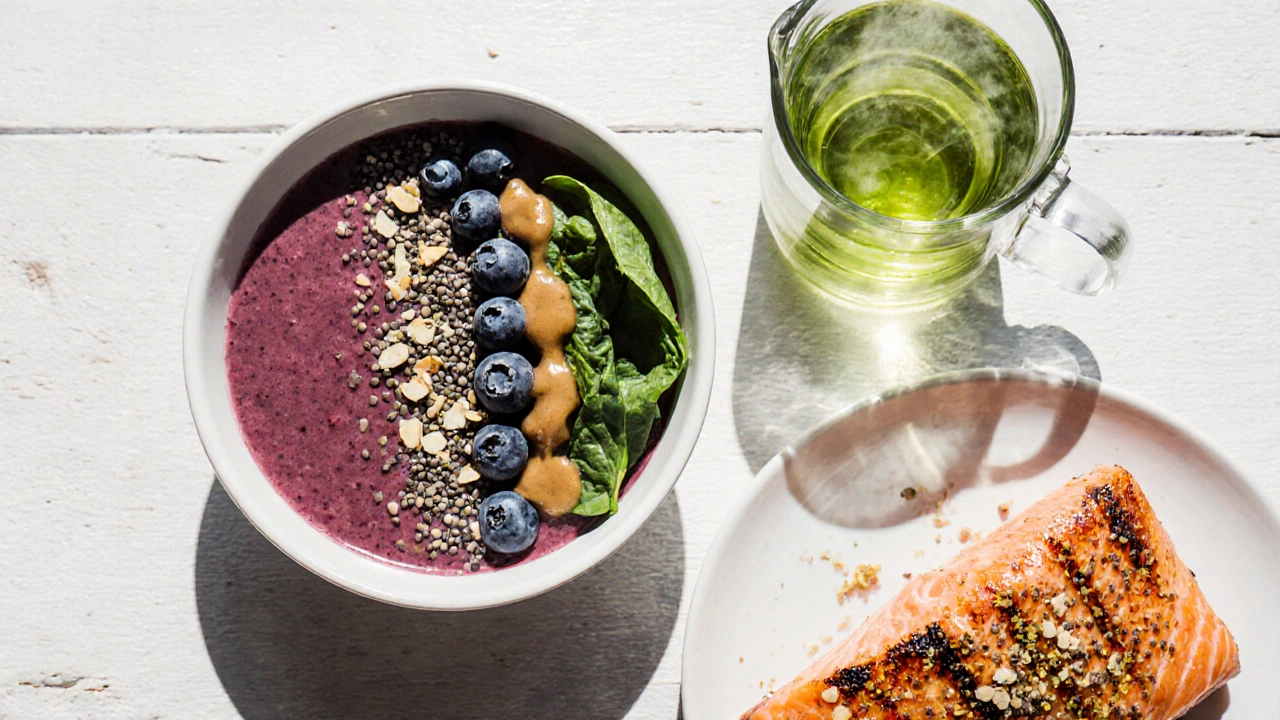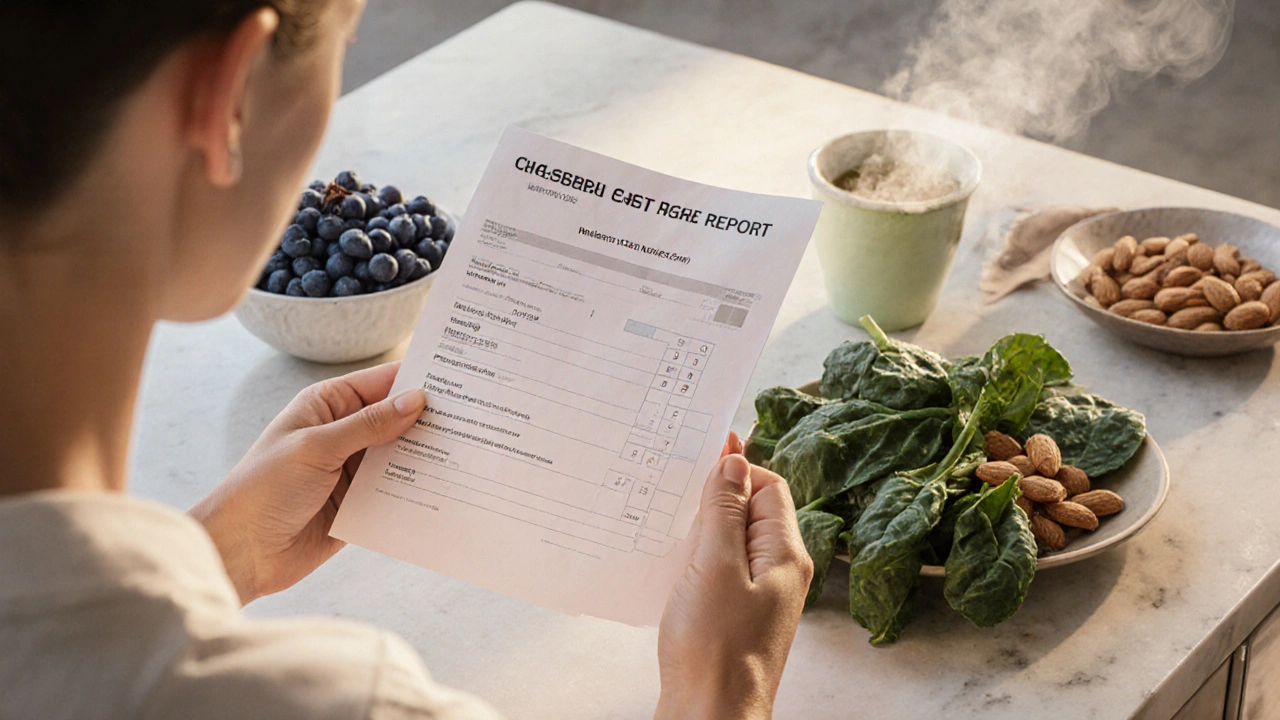Antioxidant Cholesterol Impact Calculator
Enter your cholesterol values and antioxidant intake level, then click "Calculate Antioxidant Impact" to see how antioxidants may influence your lipid profile.
If you’ve ever stared at a cholesterol test that reads "high" and felt the dread that follows, you’re not alone. The good news? You don’t have to rely solely on prescription meds or drastic diet overhauls. Certain nutrients-especially antioxidants-play a surprisingly active role in keeping cholesterol in check, protecting your arteries, and reducing heart‑related risk.
What Are Antioxidants?
Antioxidants are molecules that neutralize free radicals, unstable compounds that can damage cells and DNA. They’re found in many fruits, vegetables, nuts, and even some spices. By donating an electron without becoming harmful themselves, antioxidants stop a chain reaction that otherwise leads to oxidative stress.
Understanding Cholesterol
Cholesterol is a waxy, fat‑like substance essential for building cell membranes, hormones, and vitamin D. Your liver makes most of it, but you also ingest it through animal‑based foods. The problem shows up when low‑density lipoprotein (LDL) levels rise too high, and high‑density lipoprotein (HDL) levels stay low.
LDL, HDL, and Oxidative Stress
Low‑density lipoprotein (LDL) is the form of cholesterol that transports fats from the liver to body tissues. When LDL particles become oxidized-thanks to free radicals-they’re more likely to stick to arterial walls, forming plaques that narrow arteries.
High‑density lipoprotein (HDL) is the "good" cholesterol that carries excess cholesterol away from arteries back to the liver for removal. A healthy balance (high HDL, low LDL) is the hallmark of cardiovascular wellness.
Oxidative stress is an imbalance between free radicals and antioxidants in the body. This condition accelerates LDL oxidation, inflammation, and plaque formation.

How Antioxidants Interfere with Cholesterol Damage
Research from the American Heart Association (2023) tracked 1,200 adults with borderline high LDL. Participants who ate a diet rich in antioxidants-averaging 12µmol Trolox equivalents per day-experienced a 15% reduction in oxidized LDL after six months, compared with a control group that saw no change.
A 2022 randomized trial in the Journal of Nutrition examined 200 patients with LDL above 130mg/dL. Those who took a daily supplement containing 250mg of mixed flavonoids (quercetin, catechin, and epicatechin) showed a 9% drop in total cholesterol and a 12% rise in HDL after 12 weeks. The investigators linked the effect to decreased lipid peroxidation, measured by lower malondialdehyde (MDA) levels.
These findings highlight two mechanisms: (1) antioxidants keep LDL particles from oxidizing, and (2) they improve HDL function, helping the body clear cholesterol more efficiently.
Top Antioxidant Sources for Cholesterol Management
Not all antioxidants are created equal. Below is a quick look at foods that pack a strong punch against oxidative stress and also support healthy lipid profiles.
| Food | Main Antioxidant | ORAC Value* (µmol TE/100g) | Typical Cholesterol Effect |
|---|---|---|---|
| Blueberries | Anthocyanins | 9,600 | Lowers LDL, raises HDL |
| Almonds | VitaminE | 4,500 | Reduces total cholesterol |
| Spinach | Beta‑carotene & lutein | 1,200 | Improves HDL function |
| Green tea | Epigallocatechin gallate (EGCG) | 8,000 | Decreases LDL oxidation |
| Salmon (wild) | Astaxanthin | 2,700 | Boosts HDL, cuts triglycerides |
*ORAC = Oxygen Radical Absorbance Capacity, a laboratory measure of antioxidant power.
Practical Ways to Boost Antioxidant Intake
- Start mornings with a berry‑rich smoothie. Blend 1cup frozen blueberries, a handful of spinach, a tablespoon of almond butter, and unsweetened almond milk.
- Swap sugary drinks for green tea. Brew two cups daily; the catechins stay stable if you avoid adding milk.
- Snack on nuts, not chips. A small handful (≈30g) of raw almonds provides a steady dose of vitaminE.
- Include fatty fish 2‑3 times a week. Grill or bake wild salmon, sardines, or mackerel to tap into astaxanthin and omega‑3s.
- Season with spices. Turmeric (curcumin), cinnamon, and garlic add antioxidant compounds that further guard LDL particles.
For those with busy schedules, a dietary supplement containing a blend of vitaminC, vitaminE, and plant‑derived polyphenols can fill gaps. Look for products that specify ≥250mg of combined flavonoids per serving and have third‑party testing.

Potential Pitfalls and How to Avoid Them
While antioxidants are generally safe, excess intake-especially from high‑dose supplements-can backfire. An overdose of vitaminE, for example, has been linked in some studies to increased bleeding risk.
Here are three red flags:
- Megadoses without medical guidance. Anything above 1,000% of the Recommended Daily Allowance (RDA) should be discussed with a doctor, particularly if you’re on blood thinners.
- Supplements with synthetic antioxidants. Natural extracts (e.g., green tea extract) tend to be better absorbed than synthetic counterparts like BHT.
- Relying on supplements alone. Whole foods provide fiber, minerals, and phytochemicals that work together to improve lipid metabolism.
Balancing food sources with modest supplement use offers the safest path.
Quick Checklist for Managing Cholesterol with Antioxidants
- Consume at least 2cups of antioxidant‑rich fruits/veggies daily.
- Include a serving of nuts or seeds (≈30g) 3‑4 times per week.
- Drink 2-3 cups of green tea or herbal tea without added sugars.
- Eat fatty fish twice a week or consider a high‑quality fish oil supplement.
- Consider a daily antioxidant blend that provides 250-500mg of natural polyphenols, after checking with your healthcare provider.
- Monitor lipid panels every 3-6months to track progress.
Frequently Asked Questions
Can antioxidants replace cholesterol‑lowering medication?
No. Antioxidants support healthy cholesterol levels, but they don’t substitute for prescribed statins or other meds unless a doctor advises otherwise. Use them as a complementary strategy.
How much vitaminE should I take daily?
The RDA for adults is 15mg (22IU). A supplement providing up to 100mg is generally safe, but exceeding 1,000mg can increase bleeding risk.
Are all berries equally good for cholesterol?
Blueberries and strawberries rank highest for anthocyanin content, which most effectively reduces LDL oxidation. Raspberries and blackberries also help, but their ORAC scores are slightly lower.
Is it better to eat whole foods or drink juice?
Whole fruits retain fiber, which slows sugar absorption and supports heart health. Juice strips fiber and can spike blood sugar, so limit juice to occasional treat.
What role does exercise play alongside antioxidants?
Exercise boosts HDL levels and improves the body’s natural antioxidant enzymes. Pairing regular aerobic activity (150min/week) with an antioxidant‑rich diet maximizes cholesterol control.

13 Comments
While skimming the guide, the vivid analogies caught my eye-truly illuminating!!!
From a mechanistic standpoint, the interplay between oxidative stress and lipid peroxidation is a quintessential example of biochemical dysregulation; the article extrapolates this paradigm with commendable depth. It invokes the principle of redox homeostasis as a fulcrum for therapeutic modulation. However, the presumed linearity between antioxidant dosage and LDL attenuation oversimplifies the hormetic dose-response curve. In practice, clinical translation demands a nuanced appreciation of pharmacokinetic variability and inter-individual genotype. The narrative, albeit robust, could benefit from integrating systems biology perspectives.
the table is kinda long but i guess it helps.
Quick tip: start your day with a berry smoothie to boost those antioxidants.
Feeling a bit drained, that smoothie idea actually lifts my mood.
Honestly, the premise that loading up on antioxidants will magically fix high cholesterol is a common misconception that deserves a thorough debunking. First, the human body already maintains a sophisticated antioxidant network, including enzymes like superoxide dismutase and glutathione peroxidase, which operate autonomously without dietary input. Second, the bioavailability of many polyphenols is notoriously low; a sizable fraction is metabolized by gut microbiota before it even reaches systemic circulation. Third, randomized controlled trials often show modest or null effects when isolating single antioxidant compounds, suggesting synergy rather than singletarget efficacy. Fourth, the oxidation of LDL is a multi-step process influenced by inflammation, endothelial function, and shear stress-factors that antioxidants alone cannot fully address. Fifth, excessive supplementation, particularly of fat‑soluble vitamins like E, can paradoxically act as pro‑oxidants under certain conditions, potentially worsening lipid peroxidation. Sixth, population studies indicate that whole‑food patterns, such as the Mediterranean diet, produce more consistent cardiovascular benefits than isolated supplement regimens. Seventh, genetic polymorphisms in lipid metabolism pathways can modulate individual responses to antioxidant intake, meaning a one‑size‑fits‑all recommendation is scientifically unsound. Eighth, the cited ORAC values, while impressive in vitro, do not directly translate to in vivo efficacy due to metabolic transformation. Ninth, lifestyle variables-exercise, smoking cessation, stress management-exert a far greater impact on HDL elevation than any single dietary antioxidant. Tenth, focusing exclusively on antioxidants may distract patients from proven interventions like statins, dietary fiber, and omega‑3 fatty acids. Eleventh, the cost of high‑dose antioxidant supplements can be prohibitive, especially when the marginal benefit is uncertain. Twelfth, clinicians should prioritize personalized risk assessment, integrating lipid panels, inflammatory markers, and family history before recommending any supplement regimen. Thirteenth, further research is needed to delineate optimal dosing strategies, combination formulations, and target populations that truly benefit. Finally, while antioxidants are a valuable component of a heart‑healthy lifestyle, they are not a panacea; they should complement, not replace, evidence‑based medical and lifestyle approaches.
Great points-especially the reminder that whole‑food patterns trump isolated pills. I’ve seen patients improve their lipid profiles just by adding a handful of berries and a daily walk.
In reviewing the biochemical mechanisms presented, it becomes evident that the author has amalgamated several peer‑reviewed sources. Nonetheless, the assertion that a 500 mg antioxidant intake uniformly yields a 15 % LDL reduction lacks stratified analysis. Moreover, the discourse would profit from citing confidence intervals to elucidate variability across cohorts. Such rigor is indispensable for translational applicability.
Exactly! Let’s turn that knowledge into action-grab a green tea, toss some spinach in your lunch, and power through that cardio session. No more excuses.
Our nation’s health hinges on reclaiming ancestral diets rich in natural compounds; imposing foreign supplement trends erodes cultural resilience. The data underscores the superiority of home‑grown produce over imported synthetic blends.
While patriotic pride is admirable, dismissing scientifically validated supplements outright ignores the nuanced reality of modern nutrition. A balanced approach respects tradition while embracing evidence‑based advancements.
From a philosophical lens, the convergence of diet, lifestyle, and genetics epitomizes the holistic nature of health. Encouraging readers to explore both empirical studies and personal experiences fosters informed autonomy.
Indeed, integrating robust data with national dietary heritage maximizes cardiovascular outcomes-no need for over‑complicated jargon.
Write a comment